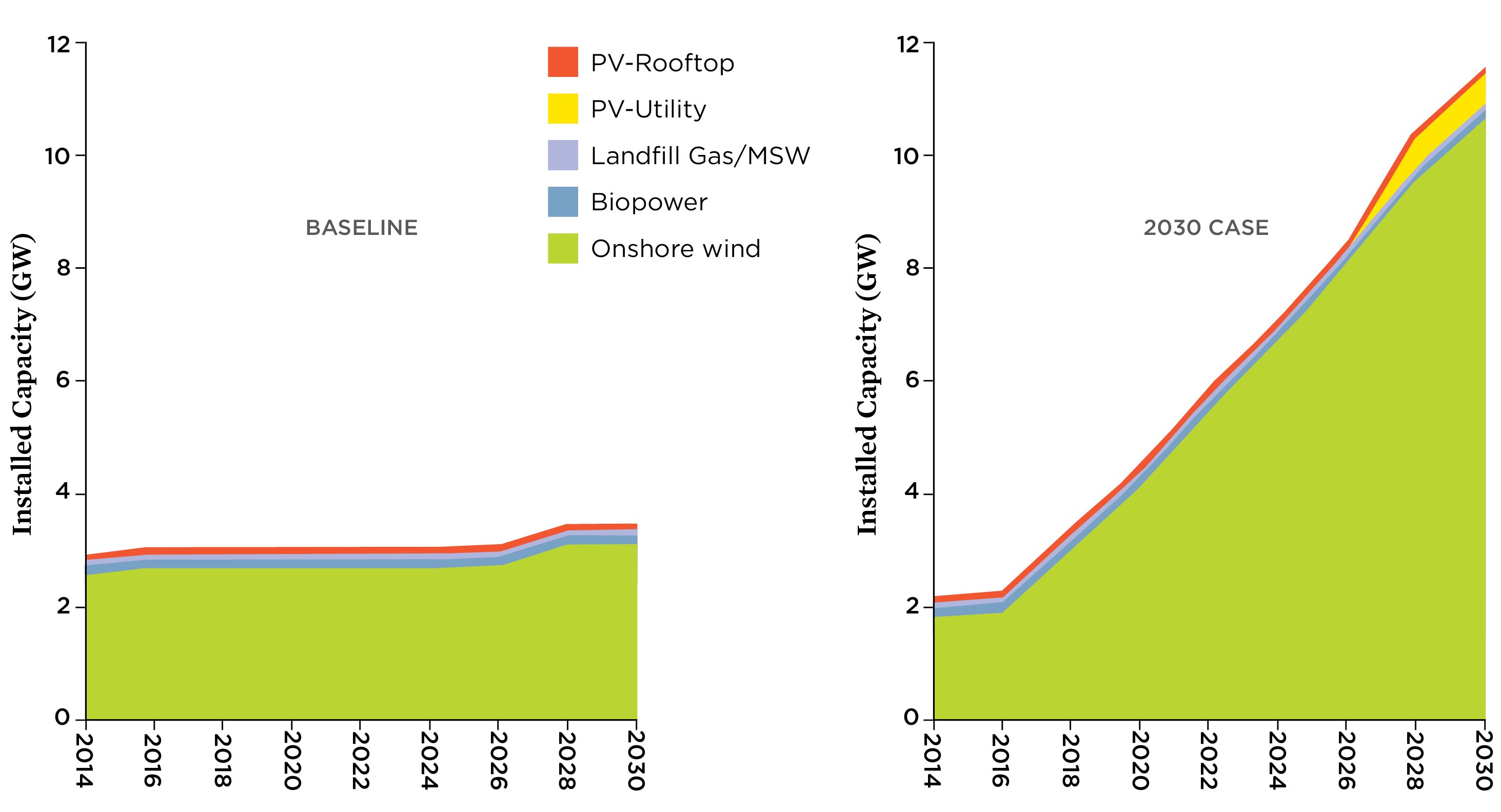With Governor Snyder’s recent announcement of clean energy goals for Michigan, the conversation is quickly developing around the future role of renewable energy in the state. To help inform that conversation, a newly released analysis by my UCS colleagues and me found that Michigan can triple its use of renewable energy — from 10 percent in 2015 to 33 percent in 2030 — at virtually no cost to consumers. Here’s how.
Keep the renewable energy transition moving
Michigan’s current renewable electricity standard (RES) — which requires utilities to meet 10 percent of the state’s electricity demand with renewable energy resources by 2015 — is a success, but it’s about to level off unless additional policies are put in place to extend it.
Michigan utilities are well on their way towards meeting the full standard, and a discussion has been underway for more than a year about what should come next. That discussion produced a wealth of information about how renewable energy is working right now for Michigan and how there’s potential to do more.
So we decided to take a deeper dive into the data and paint a clearer picture of what Michigan’s energy future might look like if it strengthens its commitment to developing renewable energy resources. Using the Regional Energy Deployment System model developed by the National Renewable Energy Laboratory, we examined the impacts on consumers, the economy, and the environment of three potential scenarios for meeting Michigan’s future electricity demand:
- Continuing without policies in place to further drive renewable energy development
- Increasing Michigan’s RES to 17.5 percent by the year 2020
- Increasing Michigan’s RES to 32.5 percent by the year 2030
Michigan can affordably meet 32.5 percent of its electricity needs and reap significant economic, public health, and environmental benefits
Our findings show that Michigan can affordably meet 32.5 percent of its electricity needs with in-state renewable energy resources by 2030 while maintaining reliability in the electricity system. Doing so will spur billions of dollars of investment in Michigan, cut electricity sector CO2 emissions, and reduce the risks to consumers of an overreliance on coal or natural gas.
What’s even better is that developing Michigan’s renewable energy resources can be done with virtually no increase in electricity costs over the next 15 years. Ramping up renewable energy to meet 32.5 percent of demand in 2030 adds just 0.3 percent to the cost of meeting Michigan’s electricity demand from 2014 to 2030. In some years, average retail electricity prices are actually lower under a 32.5 percent RES scenario. Pursuing a less robust RES, 17.5 percent by 2020, significantly reduces the economic, public health, and environmental benefits without reducing the costs.
According to our analysis, establishing a 32.5 percent by 2030 RES in Michigan means:
- Sustained and robust development of Michigan’s renewable energy resources: Michigan’s renewable energy industries would add an average of about 550 megawatts (MW) of new renewable energy capacity per year, totaling more than 11,000 MW by 2030. Without policy support beyond 2015, renewable energy development in Michigan would remain largely stagnant from 2014 to 2030.
Renewable Energy in Michigan, Business As Usual Versus a 32.5 Percent by 2030 RES

Without policy support beyond 2015, renewable energy development in Michigan remains largely stagnant from 2014 to 2030. However, under a 32.5 percent by 2030 RES, the deployment of renewable energy in Michigan averages more than 550 MW of new renewable energy per year.
- Significant economic benefits: The development of Michigan’s renewable energy resources would drive more than $9.5 billion in new capital investments from 2016 to 2030. By 2030, renewable energy facilities would also add nearly $570 million in operation and maintenance payments and more than $21 million in land lease payments annually.
Economic Investments in Michigan Under a 32.5 Percent by 2030 RES

Under a 32.5 percent by 2030 RES, more than $9.5 billion is invested in building nearly 9,400 MW of new renewable energy capacity. Annual operation and maintenance needs garner another $567 million in local spending in 2030.
- Reduced carbon dioxide (CO2) emissions: Reduced dependence on coal and natural gas would lower CO2 emissions by more than 65 million tons from 2014 to 2030—equivalent to the annual emissions of 15 typical-size (600 MW) coal plants.
- A more diverse electricity supply for Michigan: Renewable energy development, led primarily by wind energy, would displace both coal and natural gas in Michigan’s electricity generation mix, leading to lower risks to consumers resulting from an overreliance on fossil fuels to meet electricity demand.
It’s time for Michigan to increase its commitment to renewable energy by extending and strengthening its renewable electricity standard.
Michigan has vast in-state renewable energy resources — more than enough to meet the state’s 2012 electricity demand several times over. These resources remain largely untapped today as the state continues to rely heavily on its aging and inefficient coal fleet to generate electricity. This overreliance on fossil fuels generates substantial air pollution and carbon emissions, and takes a significant toll on public health, the state’s economy, and the climate. Renewable energy offers an electricity resource that is reliable, affordable, adaptable, and protective of the environment — all goals that Governor Snyder has laid out for the state’s electricity sector.
Our analysis builds on a growing list of resources showing how renewable energy is working for Michigan right now and how it can continue to provide economic, public health, and environmental benefits for the state. With Michigan’s current RES set to level off in 2015, Governor Snyder and the Michigan legislature should work toward passing an RES policy for Michigan that includes achieving at least 30 percent renewable energy by 2030. Delaying legislative action only means delaying a cleaner, more reliable, more economically beneficial energy future for Michigan.

